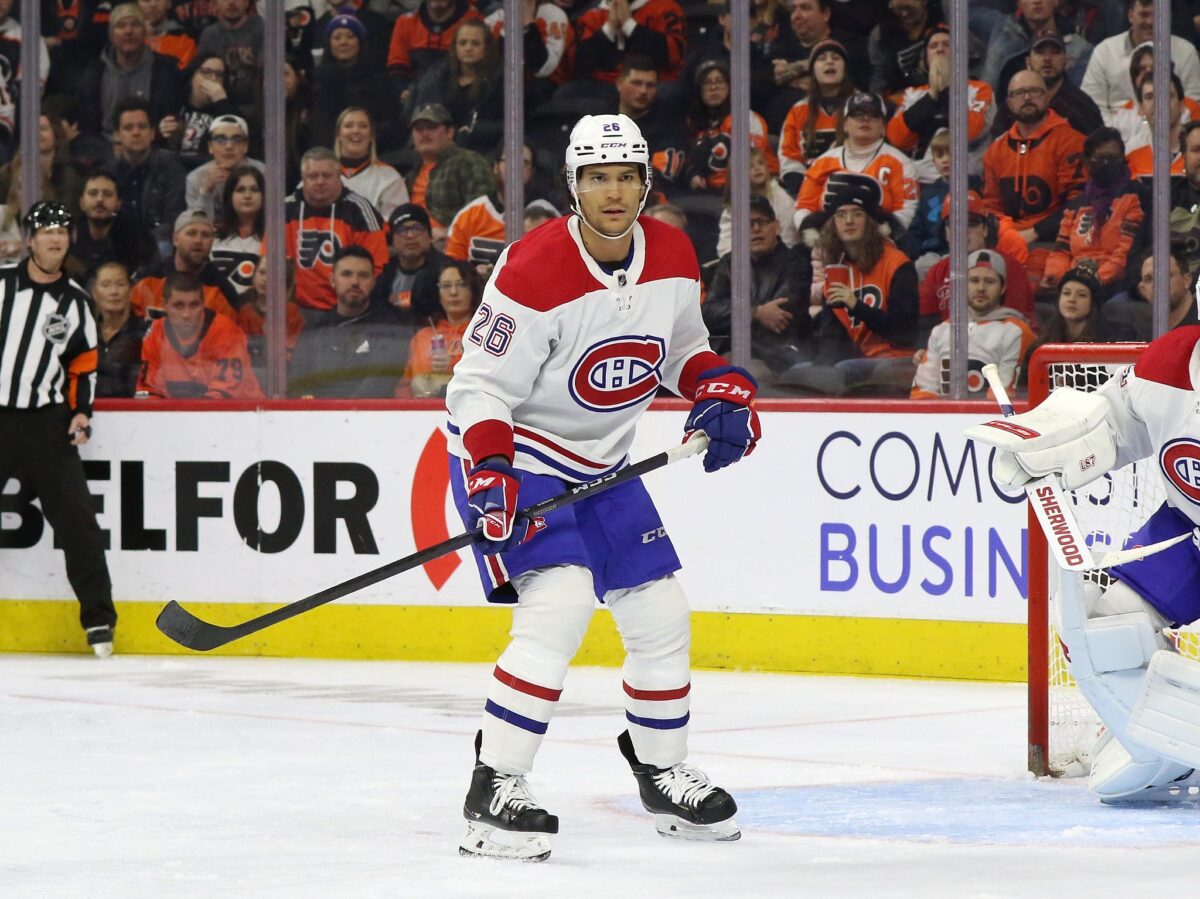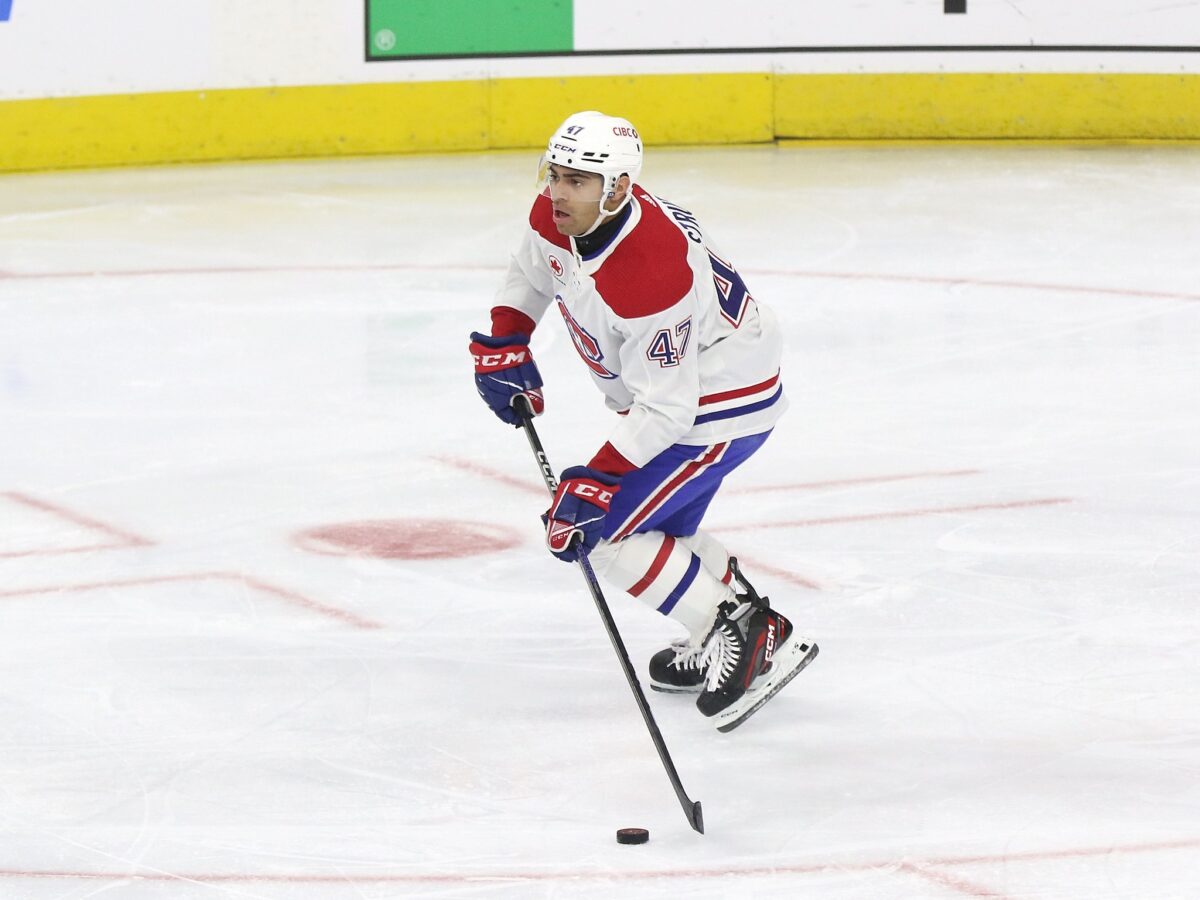Many Montreal Canadiens fans at least half-anticipated they’d trade a defenseman this offseason. While David Savard would have been ideal in a lot of ways, Johnathan Kovacevic was projected to become an unrestricted free agent in 2025 as well, making his trade to the New Jersey Devils a logical one, especially considering the prospects the Habs have coming up in the organization.
Related: Canadiens Have Work Cut Out for Them to Trade Savard
Even so, despite the spot having opened up and despite fan sentiment to the contrary, none of prospects David Reinbacher, Lane Hutson and Logan Mailloux, even coming off an all-star season in the American Hockey League, are guaranteed to stick with the Canadiens out of training camp. In fact, general manager Kent Hughes didn’t have to trade anyone at all.
It’s a safe assumption Savard, to maximize his trade value, Mike Matheson and Kaiden Guhle end up lineup locks. Jordan Harris, who’s been played on either side, could have conceivably rotated in and out with Arber Xhekaj on the left and Justin Barron, who will no longer be exempt from waivers, and Kovacevic on the right. With Kovacevic gone, the Canadiens have a decision to make, namely which singular defenseman, barring a trade, to promote to best fit the approach to give everyone ice time that they ultimately take.

A rotation continues to make sense, though. Neither of the latter three Canadiens have established themselves as mainstays. Ditto for the three prospects. However, it makes little sense to tease a spot opening up through the Kovacevic trade simply to promote (or sign) a stereotypical seventh, depth defenseman who rarely gets in the lineup. So, who’s likeliest to get the nod? It turns out, someone who hasn’t even been mentioned yet. Here are the likeliest options to fill the role of the Canadiens’ “seventh” defenseman in 2024-25:
5) Adam Engstrom (L)
Adam Engstrom makes this list as a formality… and as a red herring as someone who had not yet been mentioned in this piece. Obviously, he’s not No. 1 (and nothing’s preventing readers from scrolling down at this point), but including him was worthwhile simply because he’s a significant name on the team’s depth chart, someone who just signed his entry-level deal a few months ago and someone who projects as a top-four defenseman.
It’s perhaps a testament to the team’s recent drafting though that Engstrom is as low as he is here, because there are so many left-handed names above him on the depth chart. With that in mind, there is legitimate concern the 20-year-old will have a hard time cracking the team’s lineup altogether, but especially this coming year when he’s joining the Canadiens without any professional experience in North America. Everyone else on this list also has at least some games played within the organization.
4) David Reinbacher (R)
It’s easy to forget David Reinbacher is the youngest name on this list because of the lofty expectations laid at his feet as a fifth-overall draft pick (2023). It makes sense for the Canadiens to take their time developing him in the AHL, specifically based on the position he plays. Defensemen typically take longer to develop than forwards, which may explain why this management group deemed it worthwhile to play Juraj Slafkovsky in the NHL as an 18-year-old forward (when it far from worked out right off the bat). Hopefully that’s a lesson learned.
To be fair, Reinbacher will be on the verge of turning 20 when the season starts. However, as he only played 11 pro games played in North America last season, with the Laval Rocket, it’s unlikely he’s ready for prime time (despite the professional seasons he’s played overseas already). As has already been established, Savard is likely to play a huge role on the Canadiens on Reinbacher’s right side. The right-handed Barron is making the team. Both Guhle and Harris have been deployed there too. He’s simply guaranteed to get more ice time with the Rocket, for one more season at least.
3) Lane Hutson (L)
Some may point to the two games Hutson got in at the end of the season as proof the Canadiens have all but confirmed he’s making the team out of training camp in 2024-25. The fact is, upon signing his entry-level deal when he did, he was ineligible for the AHL. He needed to be on the AHL roster at the NHL trade deadline for the Canadiens to have been able to start him off with the Rocket. He wasn’t. So, they couldn’t. It’s that simple.
Granted, Hutson impressed with two assists in the two NHL games he played. However, he’ll have to impress further in training camp to leapfrog the likes of Matheson, Guhle, Harris and Xhekaj on his left. It simply makes more sense for the Canadiens to start him off with the Rocket, with whom he’ll presumably get in every game as arguably their most offensively dynamic defensive prospect since P.K. Subban, a fellow-second-round pick back in 2007, who only reached the NHL after a full season in the AHL, but three after getting drafted.
It goes to show, playing in the AHL isn’t an indictment of one’s talents, but a part of the process. If Subban can go on to win the James Norris Memorial Trophy as the league’s best defenseman, the Canadiens should have no issue taking a similar route here. Patience on everyone’s part is a virtue.
2) Logan Mailloux (R)
Mailloux may have been an AHL all-star. He may have gotten called up for one game to end 2023-24. However, that just means the Canadiens deemed it worthwhile to reward him with a taste in a relatively nothing game (even though it wasn’t for him). He hasn’t been promoted permanently, not when he’s still exempt from waivers, has got an entire training camp to go through in competition with everyone else on this list and, most significantly, still needs work on his defensive game.
Obviously, Mailloux’s first pro season was impressive, with 14 goals and 33 assists in72 games. However, it’s worth noting Barron, another right-handed defenseman, who will make the team barring anything unforeseen, put up points at the same rate, with 16 in 25 AHL games in 2022-23 (albeit at 21 going on 22 instead of 20 going on 21). And his game still shows significant deficiencies. They are very similar in terms of their styles of play. Little is preventing Mailloux from running into the same false starts and stops in his NHL career Barron has, except maybe more development time.
Despite his shortcomings, there’s still room for Barron in the organization based on his 18:38 average ice time, which effectively ranked fourth last season. So, there’s a need there. There is for Mailloux too, just not now, because one offensively inclined defensemen on the right side in need of help with his defense is enough. If Barron took all this time to make the permanent jump to the NHL, Mailloux will realistically take more on his end.
Mailloux just ranks as high as he does, because he’s a right-handed shot, which, with the Kovacevic trade, makes it more likely he nabs the open spot. However, that is far from the deciding factor here, especially with Guhle and Harris having played on their off sides (which would make room on the left instead).
1) Jayden Struble (L)
Like Kovacevic before him, Jayden Struble is arguably the team’s forgotten man on defense, unjustifiably so based on the relatively high degree of media attention his rookie campaign received. He did play 56 games in the NHL last season, even if the level of his play visibly decreased as it wore on. That’s to be expected for a 22, soon-to-be 23-year-old. However, if the quality of play Struble displayed upon first getting called up is any indication, affording the Canadiens the chance to keep Xhekaj down in the AHL after he returned from injury so he could work on his game, he’s got the inside track to securing a permanent spot here.

Of course, with Xhekaj having been sent down like he was, playing 17 games before ultimately playing 44 total with the Canadiens last year, two things should be clear:
- Xhekaj, with 15:56 in average ice time himself (below Struble’s 16:07 and only above Gustav Lindstrom’s 15:17) isn’t guaranteed to get in every game.
- Nothing is guaranteed for any of the players on this list, Struble included.
It’s an important distinction to make, in that Xhekaj could technically end up the “seventh” defenseman in terms of how he’s deployed. For the sake of simplicity though, the names included here are simply those likeliest to round out the team’s defense corps by making the jump to the NHL. By virtue of Struble finishing his season with the Rocket, he qualifies. However, it’s also worth noting he played in the Canadiens’ last game of the season, getting sent down to help the Rocket afterwards in their ultimately unsuccessful playoff push.
So, it’s true Struble is effectively here on a technicality. By all appearances, he’s already in the long term plans of the team on the NHL level. You wouldn’t know it though based on the way everyone talks about Reinbacher, Hutson and Mailloux, as if they’ve already made the team. They haven’t. For all intents and purposes, Struble has, or at least he’s closer to making it… the closest of the bunch.
